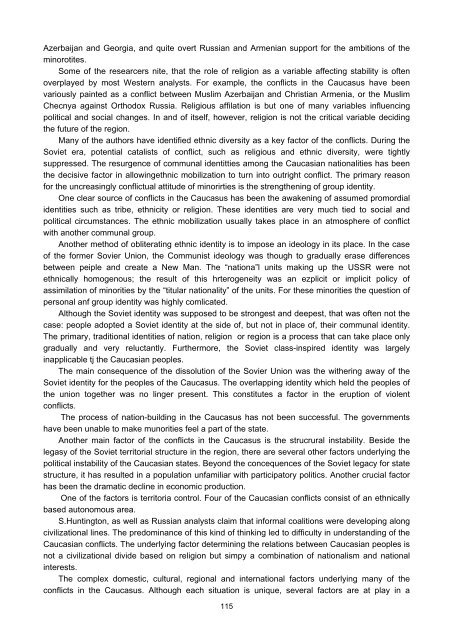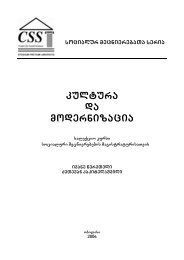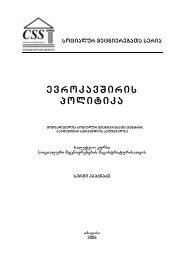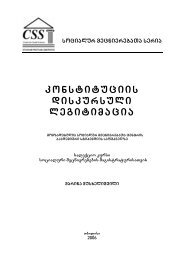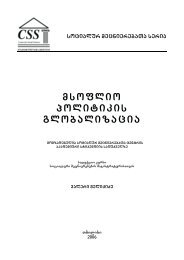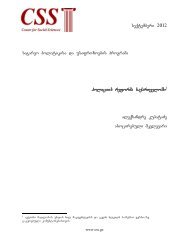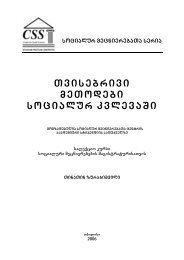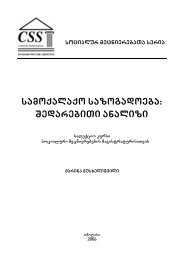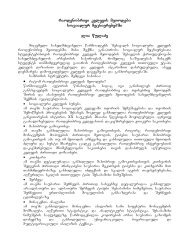kavkasiis geografiuli garemo da mosaxleoba - Center for Social ...
kavkasiis geografiuli garemo da mosaxleoba - Center for Social ...
kavkasiis geografiuli garemo da mosaxleoba - Center for Social ...
Create successful ePaper yourself
Turn your PDF publications into a flip-book with our unique Google optimized e-Paper software.
Azerbaijan and Georgia, and quite overt Russian and Armenian support <strong>for</strong> the ambitions of the<br />
minorotites.<br />
Some of the researcers nite, that the role of religion as a variable affecting stability is often<br />
overplayed by most Western analysts. For example, the conflicts in the Caucasus have been<br />
variously painted as a conflict between Muslim Azerbaijan and Christian Armenia, or the Muslim<br />
Checnya against Orthodox Russia. Religious affilation is but one of many variables influencing<br />
political and social changes. In and of itself, however, religion is not the critical variable deciding<br />
the future of the region.<br />
Many of the authors have identified ethnic diversity as a key factor of the conflicts. During the<br />
Soviet era, potential catalists of conflict, such as religious and ethnic diversity, were tightly<br />
suppressed. The resurgence of communal identitties among the Caucasian nationalities has been<br />
the decisive factor in allowingethnic mobilization to turn into outright conflict. The primary reason<br />
<strong>for</strong> the uncreasingly conflictual attitude of minorirties is the strengthening of group identity.<br />
One clear source of conflicts in the Caucasus has been the awakening of assumed promordial<br />
identities such as tribe, ethnicity or religion. These identities are very much tied to social and<br />
political circumstances. The ethnic mobilization usually takes place in an atmosphere of conflict<br />
with another communal group.<br />
Another method of obliterating ethnic identity is to impose an ideology in its place. In the case<br />
of the <strong>for</strong>mer Sovier Union, the Communist ideology was though to gradually erase differences<br />
between peiple and create a New Man. The “nationa”l units making up the USSR were not<br />
ethnically homogenous; the result of this hrterogeneity was an ezplicit or implicit policy of<br />
assimilation of minorities by the “titular nationality” of the units. For these minorities the question of<br />
personal anf group identity was highly comlicated.<br />
Although the Soviet identity was supposed to be strongest and deepest, that was often not the<br />
case: people adopted a Soviet identity at the side of, but not in place of, their communal identity.<br />
The primary, traditional identities of nation, religion or region is a process that can take place only<br />
gradually and very reluctantly. Furthermore, the Soviet class-inspired identity was largely<br />
inapplicable tj the Caucasian peoples.<br />
The main consequence of the dissolution of the Sovier Union was the withering away of the<br />
Soviet identity <strong>for</strong> the peoples of the Caucasus. The overlapping identity which held the peoples of<br />
the union together was no linger present. This constitutes a factor in the eruption of violent<br />
conflicts.<br />
The process of nation-building in the Caucasus has not been successful. The governments<br />
have been unable to make munorities feel a part of the state.<br />
Another main factor of the conflicts in the Caucasus is the strucrural instability. Beside the<br />
legasy of the Soviet territorial structure in the region, there are several other factors underlying the<br />
political instability of the Caucasian states. Beyond the concequences of the Soviet legacy <strong>for</strong> state<br />
structure, it has resulted in a population unfamiliar with participatory politics. Another crucial factor<br />
has been the dramatic decline in economic production.<br />
One of the factors is territoria control. Four of the Caucasian conflicts consist of an ethnically<br />
based autonomous area.<br />
S.Huntington, as well as Russian analysts claim that in<strong>for</strong>mal coalitions were developing along<br />
civilizational lines. The predominance of this kind of thinking led to difficulty in understanding of the<br />
Caucasian conflicts. The underlying factor determining the relations between Caucasian peoples is<br />
not a civilizational divide based on religion but simpy a combination of nationalism and national<br />
interests.<br />
The complex domestic, cultural, regional and international factors underlying many of the<br />
conflicts in the Caucasus. Although each situation is unique, several factors are at play in a<br />
115


